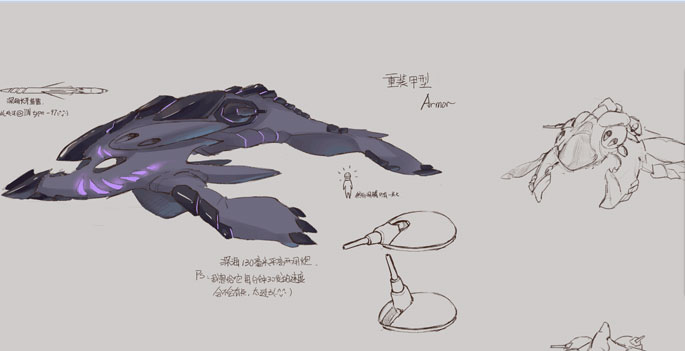Or what probably should be titled (the unusual capitalization included): The Matter of Size: Inside the Mind of the Abyssal Designer

This sketch from the Abyssal book that we’ll get around to eventually shows a few things, and I think it shows the divergence of Pacific from its source inspiration (KanColle) very early on.
The first thing you should notice is that they kinda look like oversized fish. Indeed, while the Abyssals in Pacific do have various technological components to remind the reader that they aren’t just large biological sea monsters, other than the turrets sticking out on it, you could almost expect this to pop in a fantasy as opposed to a “sci-fi” type work.
This is intentional. Thematically, we’ve determined at the start that the Abyssals start out resembling animals or other mythological creatures. They lose more and more of their “biological” traits as we proceed up to the food chain. If there is a revealed intelligence behind the form of the Abyssals, the goal here is simply psychological terror. They might not look very intimidating here on paper, but that’s only because we’ve isolated and given them form. You’re able to see with clear eyes what they are. This will not be the experience of many of those in the Pacific world. I wrote about this before, but it’s relevant to bring it up here again.
I said in that piece that Sima and myself aren’t particularly interested in the grotesque, but terror can take shape in many forms. Strip away our culture and our humanity, reduce humanity to instinct, and we are fearful of things that are larger than us like any biological creature. We are afraid of things that behave unpredictably, things that can “know” where we are, and things that we do not understand.
Anything the Abyssal can do to reduce humanity to those very basic instincts would be an asset in its arsenal. This is one reason that the Abyssals are so heavily invested in what basically amounts to psychological and morale warfare. From a practical perspective, it makes sense for them to invest resources in these “technologies.” From an author’s perspective, it gives us an extra dimension to showcase just how “evil” the Abyssals are.
Pacific is a world with clear moral absolutes. For instance, there’s no real way you can spin the Abyssal’s motivation of simply wanting to eradicate humanity as some sort of noble effort. They aren’t trying to uplift humanity to the next stage of their existence, protect their homelands, reclaim their ancestral waters, defend the environment (all of which, by the way, I’ve seen in shipgirl related works). The Abyssals insofar as STEC understands it hate you because you’re you.
Pennsy’s tongue in cheek “they hate our way of life” is not only a callback to WW2-era propaganda, but it actually helps to illustrate a very simple narrative technique I use, which is an appeal to the reader’s sense of morality.
The Abyssals use terror weapons because it is amusing to them. Your suffering entertains them. Your death pleases them. As the silent Abyssal War heat up, you’ll see more and more examples of Abyssal behavior that can largely be explained by maliciousness and cruelty over any other potential explanation. They are powerful. They are very advanced. They are very capable. But the way in which they engage humanity’s armies is … how shall I put it, a bit like a schoolyard bully relying on his sheer bulk and intimidation.
So, if I’ve played my cards right, when someone comes along to challenge the bully, so to speak, hopefully the readers would be rooting for him or her.
One particular way I’ve been taught to craft a villain that you want your readers to dislike is to create cognitive dissonance on the reader’s part. Some readers may indeed be attracted by the design of the Abyssals. Some will likely find the humanoid or human-like Abyssals attractive (because let’s face it who doesn’t want to draw cute monster girls).
By telling the reader about such acts of “evil,” however, I am counting on a few things.
One, that the reader is bothered by these descriptions enough to think about the implications behind their own thoughts. Someone who found a particular character attractive might turn around and lament that such a thing of beauty is so irredeemably hateful. Another who found a particular move interesting might pause and consider things from an in-universe perspective, how hard it might be to lose a family member, or to meet your own grisly end at one of these things.
Two, that the reader begin to ask questions of a fundamental nature. “Why does the Abyssals hate humanity?” “Do I hate my fellow humans enough to want to side with civilization destroyers?” Things like that.
Both are designed to get people to think.
By the way, what I’m telling you isn’t anything new or profound. Most people will subconsciously use these techniques. I just happened to have received some additional learning so that I can consciously focus on what I want to do in my writing. I’m only a beginner, after all!
